-By Steve Rixen– My wife, Kim and Racer Eileen Wetzel pressured me to do my best to fulfill my Walter Mitty aspiration and get my Vintage Race License, BEFORE IT’S TOO LATE! (Something, which I, at age 70, felt had already occurred!) Covid restrictions gave me the time to work on it.
So first off, I thought I needed a car and how do I do that? I have crewed for various people who had decided to go vintage racing and purchased a “Prepared” car, which had been a little less than prepared. One fellow took 2 years (many head gaskets and 2 engine re-builds) to complete over half the laps of his race weekend. I didn’t see that as a viable alternative. Where do I put another car, how do I trailer it, and with what?
For an adventure that will probably only last one or two seasons that seemed to be a little much. I have a Healey I’m confident in, it already had a roll-bar installed that was within the rule guidelines, and an adequate, trusted 25,000 mile, 7 years beyond last overhaul, slightly modified engine (160 estimated horsepower, better than the original 103) to get around the track. Not a world beater or even a local beater but adequate for what Steve Nichols, VSCR Competitions Chairman, described as driving and competing with the “Vintage Spirit”.
I only needed to add a few items to get the car into rules compliance.

Safety rules require a roll bar and although the one I had previously installed in the car was adequate (built to a height which allowed use of my factory hardtop), I decided it needed to be safer and install triangulation bars and removable forward bars which triple triangulated the roll bar and acted as anti-intrusion bars for the driver. Since I (far) exceed the norm of the Post WWII Brits height and weight, I needed to obtain a seating position 2 inches below the roll bar with helmet on, so that required buying and installing a Kirky aluminum race seat at the steepest layback angle.
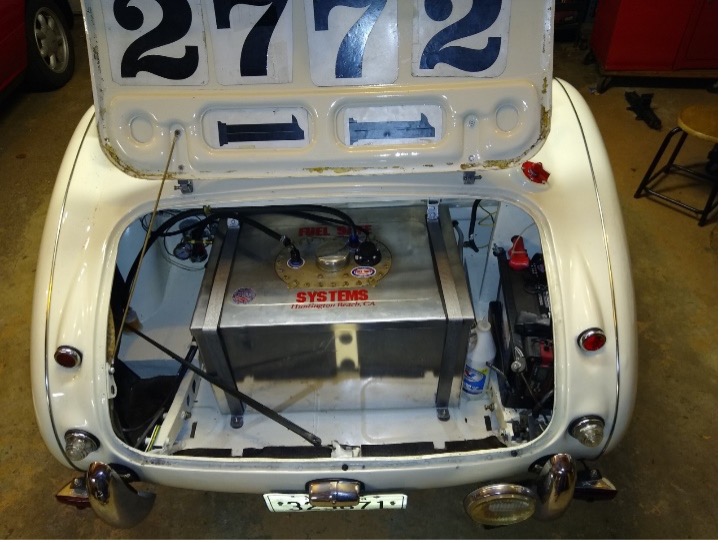
The Rules also require the installation of a Fuel Cell. This is usually about 8 Gallons capacity, but since I was considering doing low investment Old School 50’s Sports Car Racing capable of driving to the track, racing and driving home, (within current safety rules) I went with a 22-gallon fuel cell donated by Gary and Eileen Wetzel when they went to an 8-gallon tank in their Healey race car 202. Rules require a tank vent to the exterior, a catch can for the differential vapor/liquid, and 1/8 inch by 1-inch-wide tank straps. The rules also require secure battery tiedown and an electrical shut off which allows track safety personnel to shut off the engine and all electrical power in emergency, which I mounted where the stock re-fuel tube is usually located.

My wooden steering wheel would not pass inspection so I replaced it with a smaller diameter metal rim padded Motolita wheel. It also allows me to get my right foot and leg into the footwell.
The engine rules require a catch can for the crankcase and the radiator. My car has a recovery tank on the radiator, that is the small white plastic cap in lower center, and a plastic tube from the valve cover to the mandated crankcase catch can under the shroud. Also visible are the handy fuel pressure regulator and gauge. There is an electric pusher fan on the 4 row Heavy Duty radiator.

Numbers and roundels on sides, rear and front are removeable, I removed the front and rear driving lights, taped the remaining lights, (front and rear), removed the windshield wiper arms, mounted the required 1A 10BC portable fire extinguisher, installed the required identification, safety and tow decals and impact tolerant foam on the roll bar near my helmet area. This brings the car into safety compliance.
I also sourced used Vintage specified bias ply Hoosier race tires and extra wheels from Gary Wetzel when they upgraded to radials for 202. I later upgraded to Hoosier Speedster radials after treadwear on two of those required purchase of tires.
A new, conforming Snell SA2022 specification helmet, Nomex driver’s suit, Nomex underwear, gloves, arm restraints, (size 14!) race shoes and a head and neck restraint brought my personal safety equipment into GCR (General Competition Rules) compliance.
A current doctor’s physical was required prior to attending a VSCDA Vintage Driving School at Gingerman Raceway (South Haven), Michigan the end of April. The car passed technical inspection by the VSCDA and VSCR, (the inspector described it as “A proper Vintage Racecar.”) and I passed my required Physical.

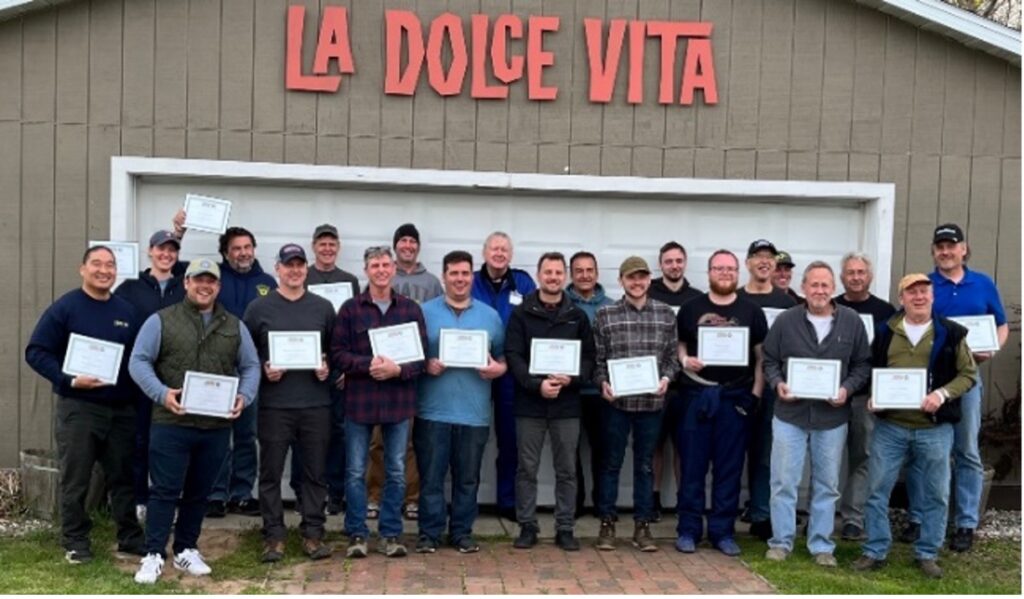

So, I haven’t invested in a $20,000, 225 HP race engine going big bucks, so the car is pretty much as it would have been run “Back in the Day” 1960-ish. As longtime friend, instigator of dreams and supporter; club and vintage racer Rich Stadther assured me I’ll find someone to race around with and get the experience I’ve been seeking. A successful personal Walter Mitty adventure and season was seen as completing Vintage Race school and getting through a few race weekends.
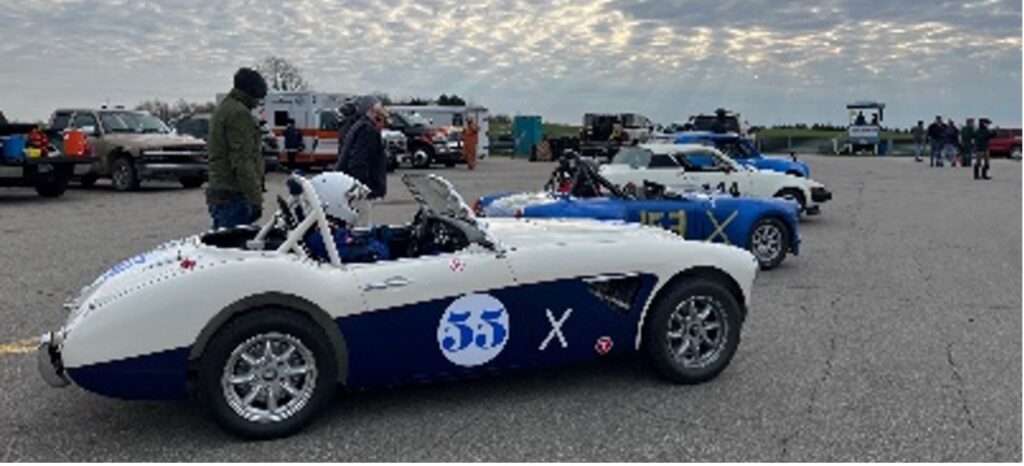
So far, I’ve completed the school and successfully raced the three open, non-instructional VSCDA races at Gingerman, and two race weekends at Brainerd International Raceway under the auspices of the local VSCR group (Vintage Sports Car Racing) more or less successfully.
May’s Harvey West Memorial Day Classic at BIR found me with casting sand and liberated rust which had broken loose from an obscure corner of the cooling system during the first practice session, causing loss of pressurization, (gunk under the pressure cap seal) and overheating after 4 or 5 laps. I ran what laps I could during each session that weekend, came home and flushed the system repeatedly before running all the laps available at the 4th of July weekend Midsummer Classic, bringing my lap times down to just over 2 minutes at BIR.
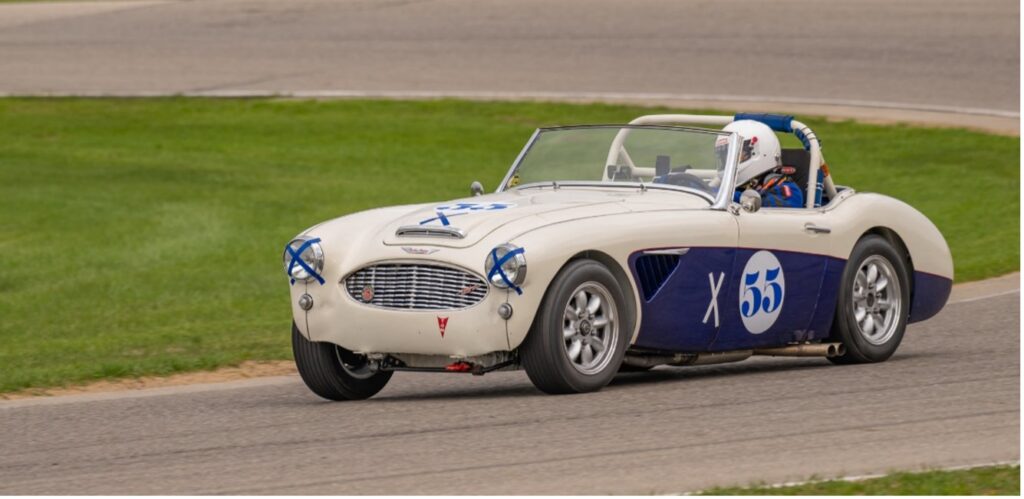
The Xs on the car indicate that at 72 I am still a vintage race rookie.
With the help, advice and good wishes of many people I have had that successful season, thus far and looking forward to the Labor Day weekend race at BIR.
After that I’ll think about next year.
So, Here I am, race school graduate, Vintage Licensed, and achieving the Walter Mitty dream from my childhood. See picture below.
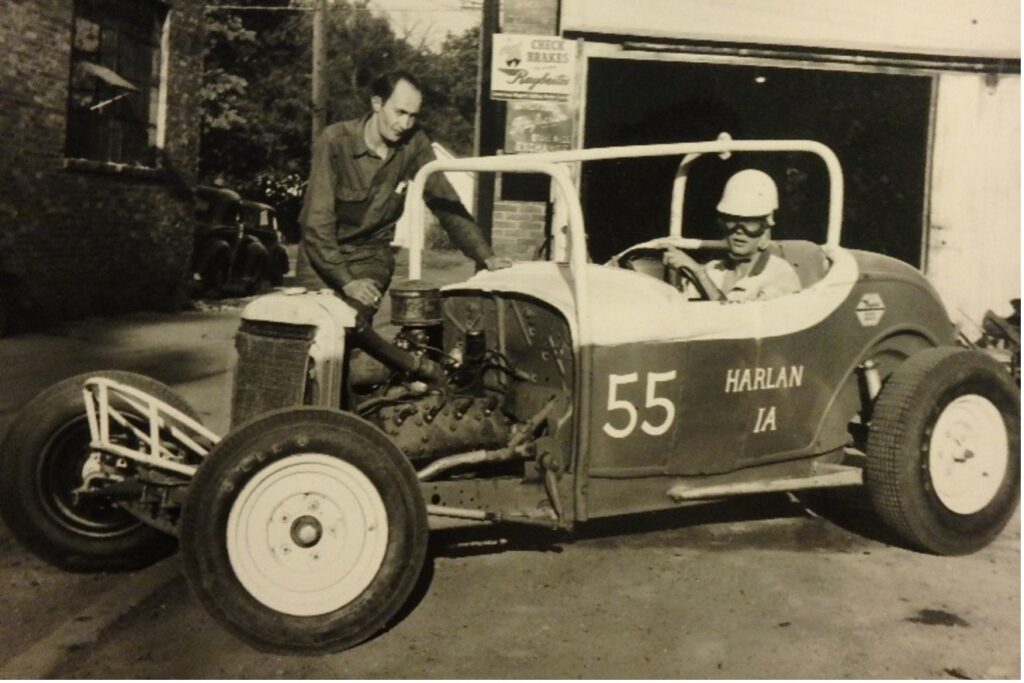
Hero Driver (in his 8-year-old mind) Steve in a Posed Picture from about 1957 with the tolerantly amused owner/mechanic and friend of my dad, Dale Swanson. Note in the photo the car number 55 was used by Dale Swanson on all his cars on local dirt tracks and when he competed in early NASCAR races at Daytona Beach in the 50s and 60s. When I joined VSCR and found number 55 was available I chose it to complete the circle.